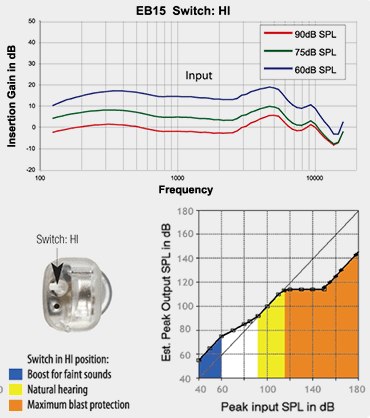Who Needs $450 Electronically Enhanced Earplugs?
 |
Remember that scene in Black Hawk Down where a soldier literally goes deaf because his buddy is shooting a giant machine gun right next to his head? The movie played it for laughs, but military hearing loss is no joke. According to high-end audio company Etymotic Research, “an alarmingly high percentage of deployed soldiers” sustain permanent hearing loss and tinnitus.
Earplugs are the obvious solution, but you can’t exactly stay frosty on patrol when you’ve got foam jammed in your ears blocking everything out. Etymotic’s EB15 BlastPLG earplugs attempt to square the circle by electronically attentuating sudden blast sounds while letting normal decibel levels through – or even enhancing them.
The $450 price tag makes sense when you consider that the EB15 is a state of the art hearing aid and earplug at the same time. “Adaptive attentuation” circuitry detects incoming impulse noise like gunfire and RPG explosions and electronically morphs into a 15-dB earplug before your eardrum takes a beating. It does the same thing if ambient noise rises to a damaging level for a sustained amount of time. Otherwise, the EB15 lets the user hear well enough to detect sounds normally and pinpoint their locations, or even boost the signal for enhanced situational awareness.

Etymotic’s BlastPLG earplugs won an Innovation award at the upcoming 2011 Consumer Electronics Show. No word yet on whether they work well against snoring spouses or shrieking toddlers.
Keep Reading
Most Popular
Large language models can do jaw-dropping things. But nobody knows exactly why.
And that's a problem. Figuring it out is one of the biggest scientific puzzles of our time and a crucial step towards controlling more powerful future models.
The problem with plug-in hybrids? Their drivers.
Plug-in hybrids are often sold as a transition to EVs, but new data from Europe shows we’re still underestimating the emissions they produce.
Google DeepMind’s new generative model makes Super Mario–like games from scratch
Genie learns how to control games by watching hours and hours of video. It could help train next-gen robots too.
How scientists traced a mysterious covid case back to six toilets
When wastewater surveillance turns into a hunt for a single infected individual, the ethics get tricky.
Stay connected
Get the latest updates from
MIT Technology Review
Discover special offers, top stories, upcoming events, and more.